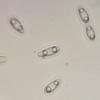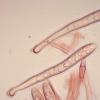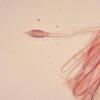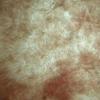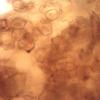
30-12-2025 17:14
 Bernard CLESSE
Bernard CLESSE
Bonjour à toutes et tous,Pourriez-vous aider Albe

29-12-2025 10:15
Hulda Caroline HolteHello, I found and collected this propoloid ascom

30-12-2025 16:44
Pascal DucosBonjour,Une anamorphe rose stipitée, très nombre

30-12-2025 09:04
Hello.A Pyrenomycete sprouting sparsely but very d

29-12-2025 17:44
Isabelle CharissouBonjour,J'aimerais savoir si d'autres personnes au

12-11-2021 00:03
Lepista ZacariasHi everybody,A week ago in my fiels trip I noticed

29-12-2025 17:12
 Bernard CLESSE
Bernard CLESSE
Bonjour à toutes et tous,Pourriez-vous m'aider à
J'apprécierais grandement votre aide pour identifier cet ascomycète qui poussait sur bois, probablement de conifère. Les apothécies mesuraient 2,3-2,7 cm de hauteur, et certaines poussaient en troupes denses. Le pied était petit ou absent, et le champignon était fixé latéralement sur le bois.
Voici mes données micro:
Spores 7-9 x 3-3,5 cm, lisses (bleu coton), bisériées.
Asques : munis de petits crochets, inoperculés, 72-80 x 5,5-6,5.
Paraphyses de deux types, les plus gros de 3-4,5 à l'apex, et l'autre type, droit, de 2-3 µm à l'apex.
Medulla en textura epidermoidea.
Excipulum ectal composé de cellules globuleuses.
Un pigment violacé diffusait dans l'eau d'examen.
Aucune réaction IKI après prétraitement au KOH.
Un grand merci.
Renée Lebeuf

Amitiés
jean pierre

that is a wonderful fungus! Ionomidotis irregularis. Did you notice the purple dye that extrudes in KOH?
The fungus grows on deciduous wood usually, mainly Fagus. If you have parts of the wood you can check that easily.
Zotto ?
Merci beaucoup Jean-Pierre et Zotto pour ces réponses très rapides. Je n'avais vraiment aucune idée où chercher, et ces paraphyses avaient une forme si particulière...
Zotto, I just put a piece in KOH and an intense purple pigment diffused. I did notice the same purple pigment in water, but to a much lesser extent. Can you tell me how to check if I have deciduous ou conifer wood? I still have a big piece of wood here.
Thanks!
Renée
After looking in the Internet, I realize that this is a rare species. It is the second time we find it. The first one was on August 9, 2009, in a mixed forest one hour north of Montreal, and the second one today on the Montreal island in a mixed forest also. So it will be nice to report it for the first time from Quebec!
Thanks again.
Renée

You can try a macrophoto of the wood with a macrolens of such a cross break.
Zotto
Renée
La réaction avec le KOH, relevée plus haut, a été nommée Ionomidotic par Korf, (francisée en ionomidotique). Cette coloration a également été identifiée chez d'autres espèces, notamment du genre Claussenomyces et dans certains genres de Hyaloscyphaceae, comme chez Solenopesia leucostoma.
Cordialement à tous
René
?




